Both groups will welcome Margherita Ganeri, Ph.D., an award-winning visiting scholar from Italy, this April. Ganeri is a professor at the University of Calabria, where she teaches contemporary Italian literature. She has been awarded two Fulbrights and one DAAD Scholarship and has served as a visiting professor at schools worldwide.
On April 17 at the Lincoln Center campus, Ganeri will discuss the Italian Diaspora with two scholars: poet and SUNY Binghamton professor emerita Maria Mazziotti Gillan and poet, essayist, and photographer Mark Hillringhouse. Gillan and Hillringhouse have participated and published through the Italian Diaspora Studies Seminar, a residential program directed by Ganeri, where they explored a southern region of Italy known as Calabria and documented their experiences. The event, “Celebrating Calabria: Writing Heritage and Memory,” will be held from 5:30 to 6:45 p.m. in Lowenstein, Room 524.
On April 19 at the Rose Hill campus, Ganeri will join Kathleen LaPenta, Ph.D., a senior Italian studies lecturer and co-director of Fordham’s Bronx Italian American History Initiative, an oral history research project documenting the history of Italians and Italian Americans in the Bronx in the 20th century. Ganeri and LaPenta will reflect on memories of Italy as told by Italian immigrants themselves. LaPenta will present research from the BIAHI oral history project and Ganeri will discuss the annual writing retreat of the Italian Diaspora Seminar. The event, “From Italy to the Bronx and Back,” will be held from 5 to 6:30 p.m. in the O’Hare Special Collections, located on the fourth floor of the Walsh Library.
“I am delighted to welcome Dr. Ganeri to Fordham to continue our collaboration, to bring the living memories of Italy into dialogue with Dr. Ganeri’s seminar, and to offer a glimpse of the creative and humanistic potential of oral histories and cultural exchange,” LaPenta said.
]]>Photos by Argenis ApolinarioStudents heading to the Walsh Family Library to study for finals will be met with a little something extra as they pass through the exhibit hall: a dead Snow White and a swarm of plastic ants.
Break Out—You Can Do It! and Is it a Crime?, the pieces featuring the Disney princess and the insects, are two of 10 pieces that comprise “Gender Comics,” a new art exhibition that runs through Dec. 13.
The exhibit features drawings, comic books, comic strips, zines, prints, web comics, animated comics, and comics objects. All were done by women art students from Austria who were part a partnership between the University of Art and Design Linz (Austria) and Fordham’s German program. The two groups joined forces during the COVID lockdown in a team-taught COIL (Connecting Research to Collaborative International Learning) course that brought together students from either side of the Atlantic Ocean.
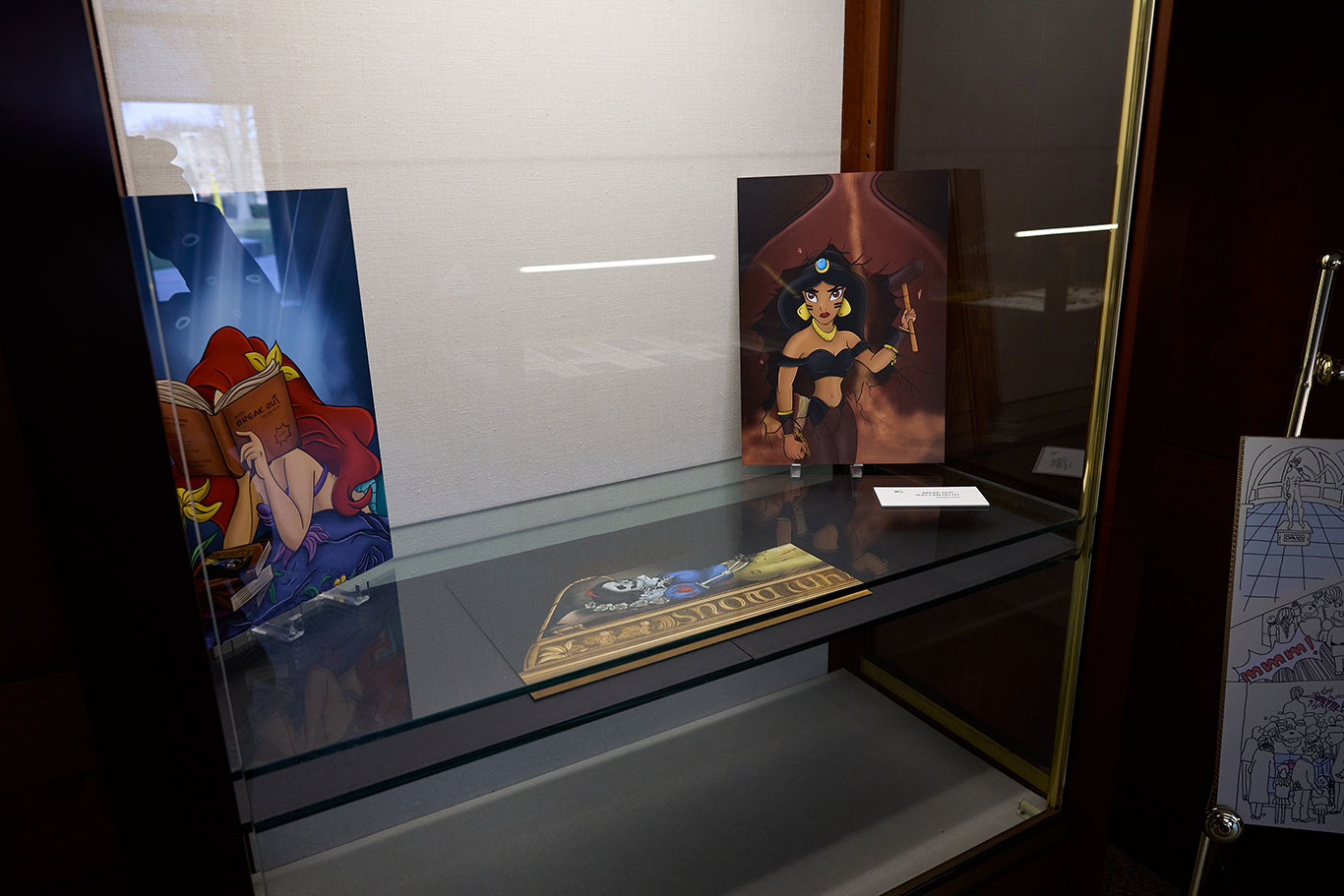
For that class, Susanne Hafner, Ph.D., professor of modern languages and literatures, asked the Fordham undergraduate students to work with the Austrian students, enrolled in a class about comics taught by Barbara M. Eggert, Ph.D., assistant professor of art at the Linz university. Together, the students conducted interviews in German with artists who had previously displayed their work at the NEXTCOMIC Festival in Linz in 2020. Their interviews will be published in the We are family! Kritische Perspektiven auf soziale Mikrostrukturen in Comics, in the journal deGruyter.
A Reunion in New York
Once international travel resumed, Hafner and Eggert arranged an in-person reunion with the students. Five of the Austrian students arrived in New York last weekend to help set up and give tours during an opening reception on Dec. 1, with plans to stay for a week at locations around the city.
“What we were dreaming about was that after a semester together online, we would actually be able to visit each other. So this is the visit from the Austrians for them. Now we’re working to get the Fordham students who are part of this publication to visit the next big comic exhibition in Linz,” she said.
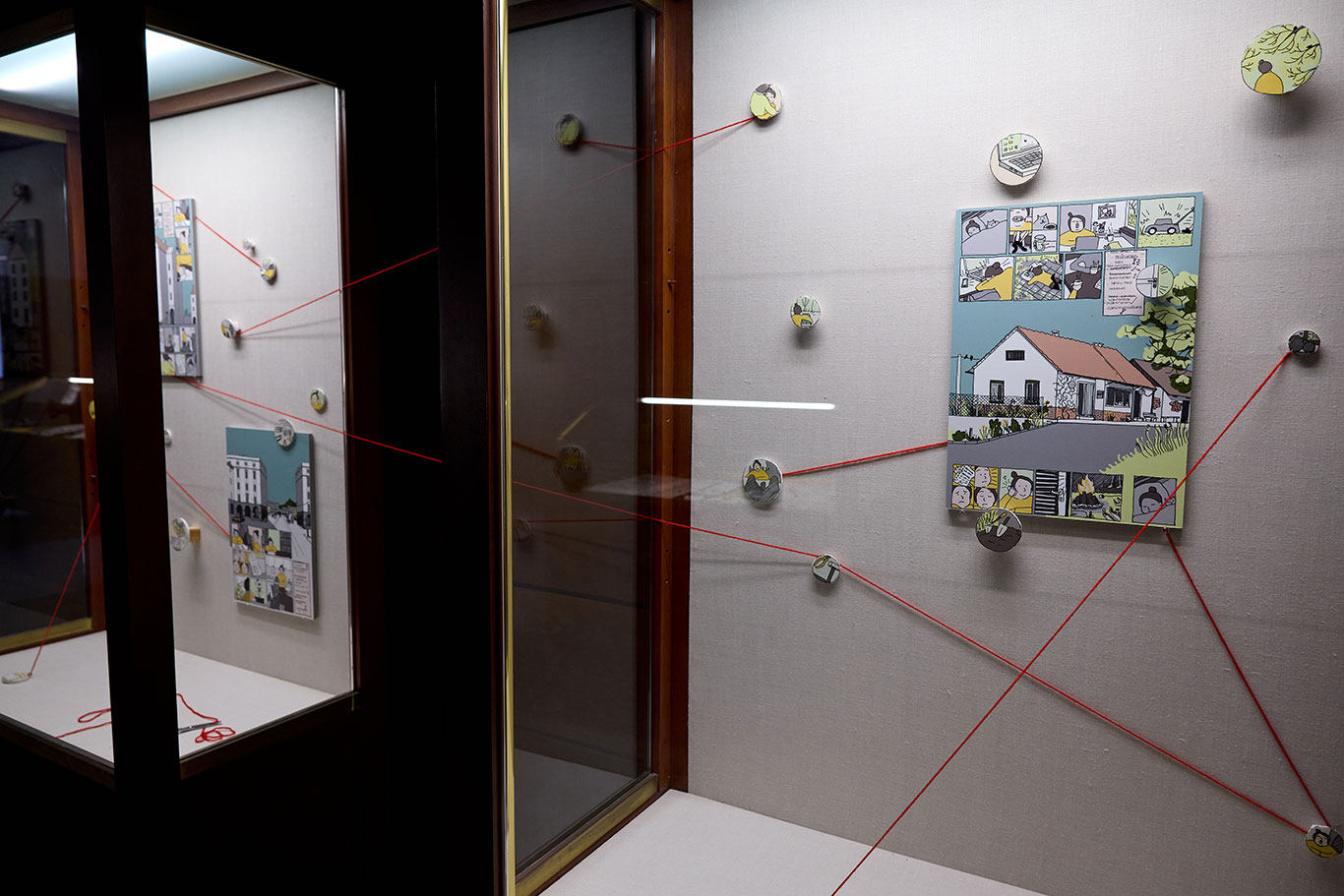
Most of the pieces had been shown in Austria before, some at the NEXTCOMIC Festival in Linz in 2021 and 2022. But several were created just for the Fordham exhibition.
Playing on Gender Stereotypes
All of the pieces in the exhibit deal with gender-related stereotypes. Eggert said that the goal is to push the boundaries of what could be described as a comic, and show how the form, which has historically been created by and for a male audience, has been embraced by women. In Lisa’s Odyssey, for instance, artist Lisa Marie Gmeindl connected various roles she inhabits, from student to girlfriend, daughter, partner, and homeowner, to each other through red string that leaps from one display case to another. In Inside the U-NIVERSE, the artist Phea displays nearly two dozen drawings, sculptures, and objects that build on interpretations of an androgynous face.
Break Out—You Can Do It! criticizes the ways Disney princesses promote the social stereotyping of gender roles, and makes the case that they should not wait for their prince to rescue them. Is it a Crime?, a sprawling installation evocative of graphics novels, combines two perspectives on trans-species interactions, in a scenario that blends 1990’s era San Francisco with a fantastical parallel universe.
Much attention has been given to the space as well.
“We decided that it’s much more interesting to show these boundary-pushing comic objects in a very formal setting, because you have this tension between the formal setting and what you would expect to see in it,” Eggert said.
“You have, for example, plastic ants in Is it a Crime, or the ribbons crossing over in Lisa’s Odyssey. It’s more interesting to work against the structure here than at a gallery, where you can do pretty much anything.”
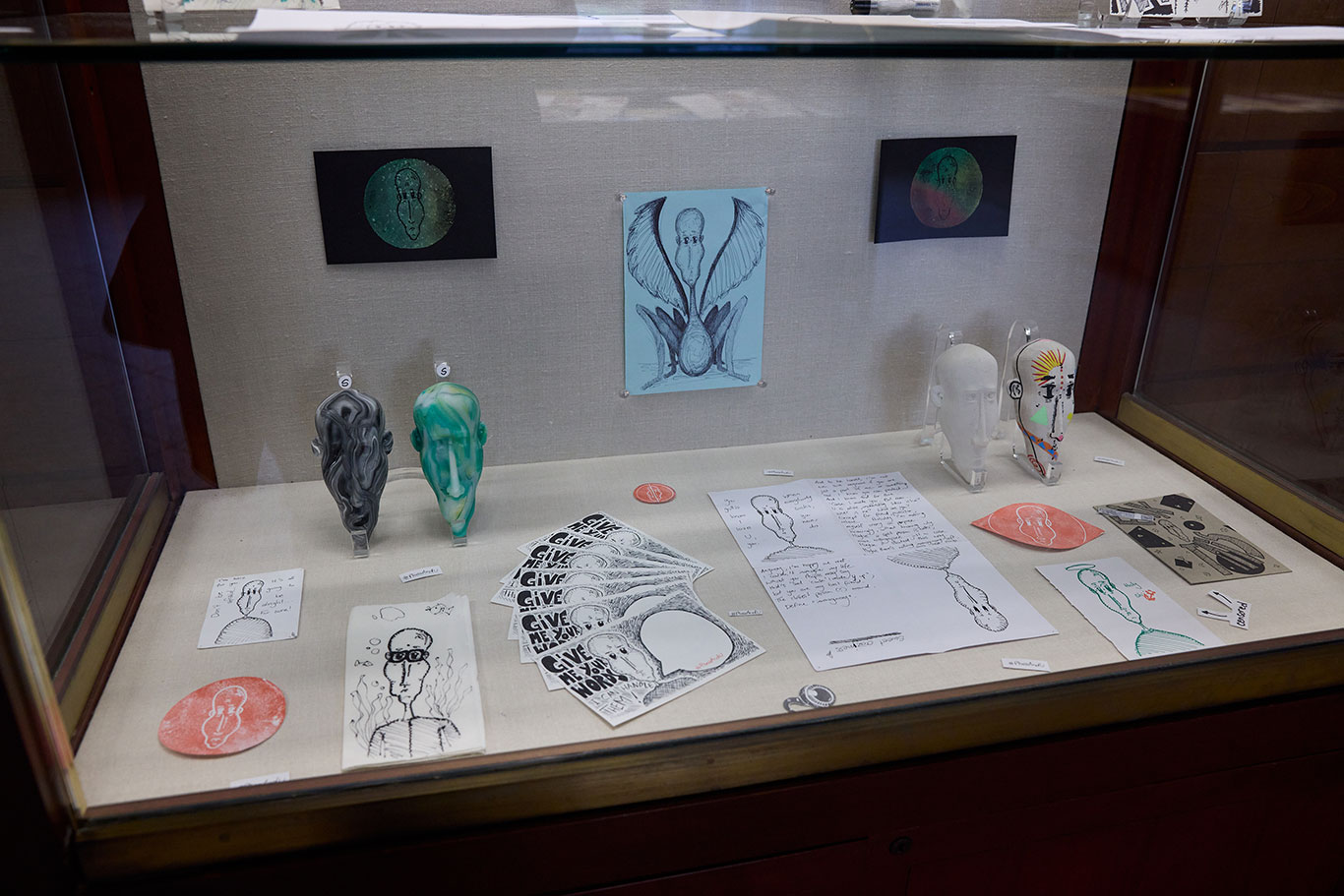
The five visiting students helped organize an opening reception where—owing to prohibitions against alcohol in the space—drawings of “drinks” were offered up. Eggert is also using the opportunity to study the library’s recently acquired selection of Catholic comic books.
Speaking Through Pictures
Anja Wittmann, a recent graduate of the Austrian University of Art and Design who contributed the 12-panel piece Better Earth, said she was drawn to the comic form because she likes telling stories, but doesn’t consider herself a good writer.
“Emotions are much easier to carry in a picture than in a text,” she said.
“One thing that’s great is it’s universal. My comics have a few words in them and they’re in English, but someone who doesn’t speak English could also understand it.”
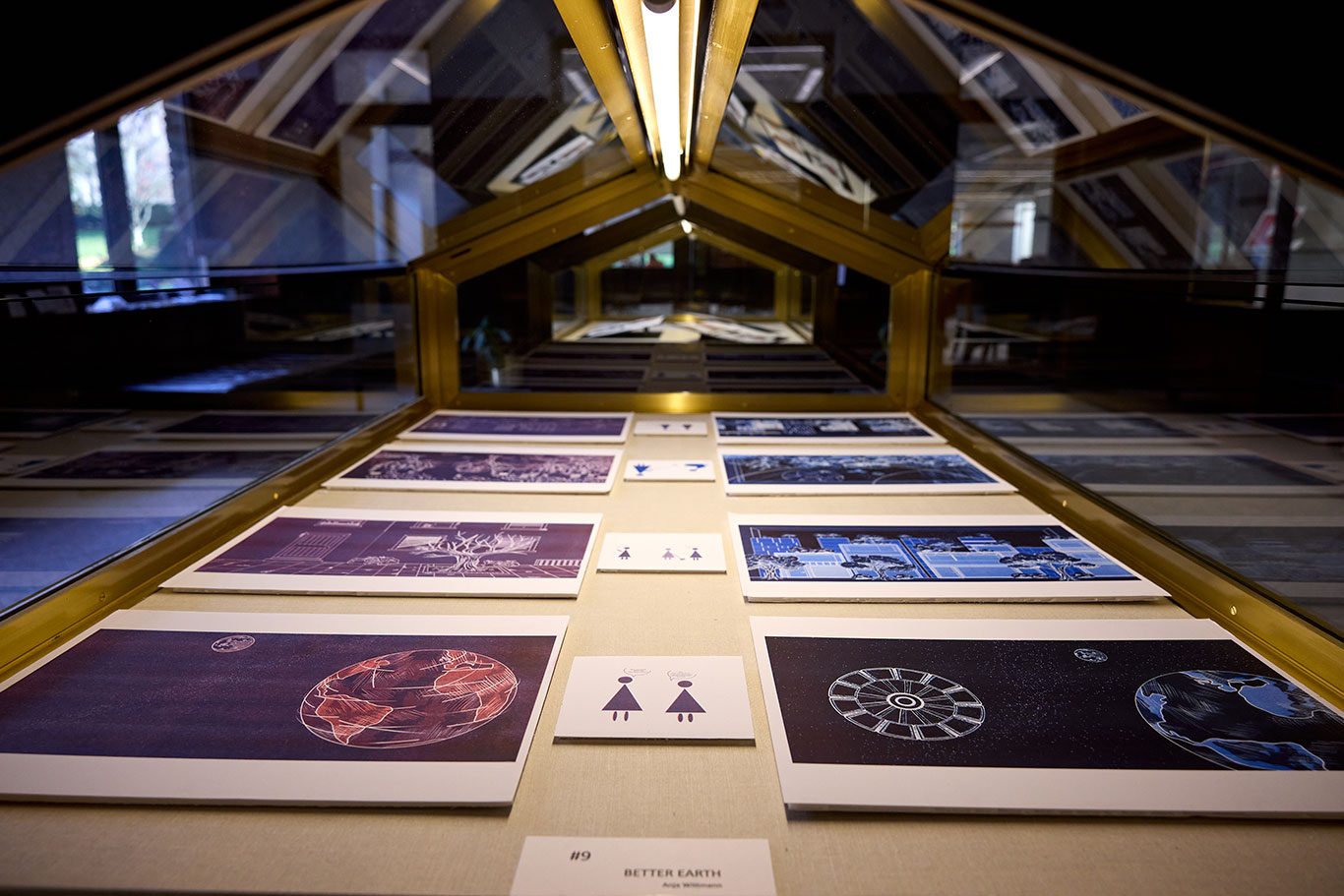
Lisa Baumgartner, a senior at the Austrian university whose three-panel Perspectives is arrayed like a triangle under a display case, said the sheer number of styles on display show how easy it is for anyone to take up the form.
“I think it’s a good way to motivate other people to scribble around, and not always feel like they have to do something highly professional. Just to try to sometimes speak in pictures,” she said.
“We are doing this all the time with emojis on WhatsApp or whatever, but we are not doing this in daily life. Why not?”
Exhibits marked with a sticky dot are available for sale, with proceeds going toward the purchase of comics for the library that address aspects of diversity including age, class, dis/ability, race and gender. Bids start at $5, and can be submitted via e-mail to Eggert at barbara-margarethe.eggert@ufg.
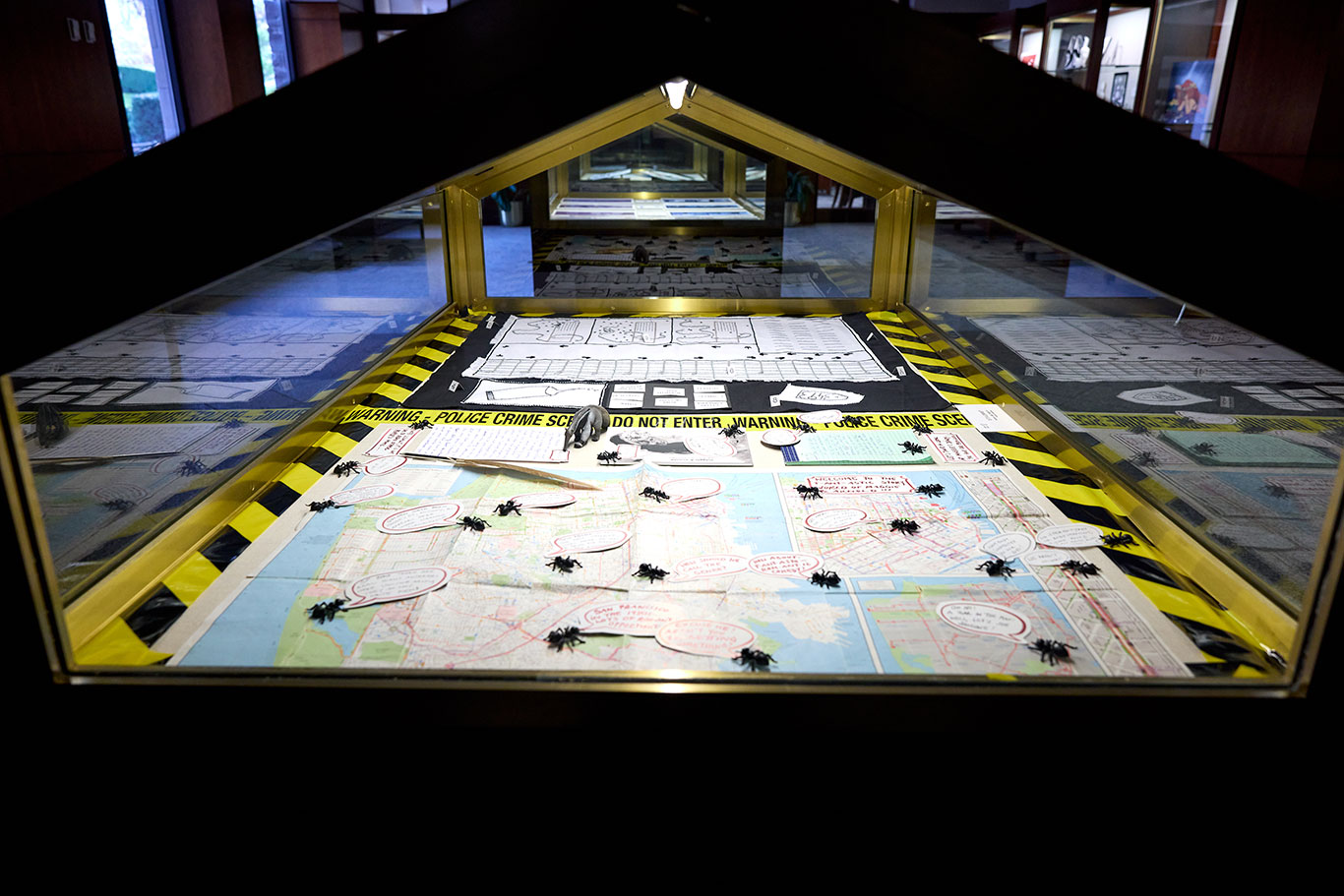
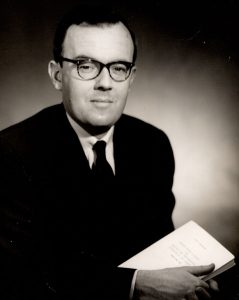
“Leo was an extremely active and committed member of the modern language and literatures department,” said Andrew Clark, Ph.D., the department’s current chair and professor of French and comparative literature, who worked with him from 2003 to 2015. Clark noted that Hoar served on multiple committees and advocated in particular for international education. He was also an active participant in Fordham’s ROTC program and a moderator for the university’s sailing team.
Clark said Hoar’s true passion was Cervantes, widely regarded as the greatest writer in the Spanish language and revered for The Ingenious Gentleman Don Quixote of La Mancha, which he penned in the early 17th century. When Hoar joined the faculty in 1963, he took over the then 11-year-old Fordham Cervantes lectures, which had enjoyed international acclaim as the only continuous event of its kind devoted to Cervantes. He oversaw multi-day conferences held to commemorate 25-, 40-, and 50-year anniversaries of the lectures.

A native of Worchester, Massachusetts, Hoar served in the U.S. Army from 1953 to 1955 and was discharged with the rank of second lieutenant. He earned a Ph.D. in Romance languages and literatures from Harvard University in 1965. He started teaching at Fordham as an instructor in 1963, became an assistant professor in 1965, and was promoted to associate professor in 1970.
In 2003, he was honored with a Bene Merenti medal for 40 years of service at Fordham and lauded as an enthusiastic and demanding teacher who developed innovative teaching methods and helped organize study abroad trips to Spain. In 2015, he retired after 53 years of service to the University.
A Home at Rose Hill
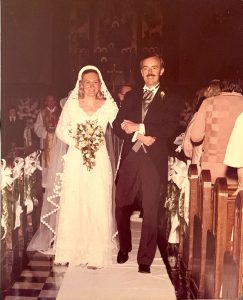
Even after he retired, Hoar regularly visited the Rose Hill campus and was a fixture on the fifth floor of Faber Hall, where the department is located. From that vantage point, he could gaze down on the University Church, where he and his wife Georgine were married on the United States bicentennial, July 4, 1976.
The two met at Fordham in 1966, when Georgine was teaching full-time for the department. They two bonded over a love of the works of the novelist Benito Pérez Galdós; he was a focus of her master’s thesis, and he would go on to publish Benito Pérez Galdós y la revista del movimiento intelectual de Europa, Madrid, 1865-1867 (Madrid, 1968).
They honeymooned in Canary Island Gran Canaria, the birthplace of Galdós. After their children were born, Georgine continued to teach as an adjunct; she also served as a moderator for the foreign language society Alpha Mu Gamma and worked with Hoar on the Cervantes lectures.
When she was also honored for 40 years of service in 2017, it was estimated that between her and her husband, the two had 100 years of teaching experience between them, adding up to 200 semesters and about 12,500 students.
“Fordham is really our home. It’s where we met, and we never counted the years. Leo always said that he would just never retire. It was the love of his life to teach the students,” Georgine said.
“He was known as a tough grader, but fair, and the students always enjoyed him because he had a wonderful sense of humor. He absolutely enjoyed what he did. If he had a 10 a.m. class, he was in his office at 8.”
Cherishing the Life of the Mind
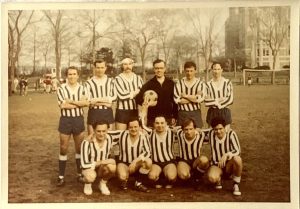
His daughter Jennifer Hoar said she spent so much time as a child with her father on the Rose Hill Campus that when she moved out to Los Angeles, she attended—and made friends at—a Fordham alumni event even though she went to Georgetown University. She said she never met someone who was as passionate about his work as her father.
“We’d be on vacation, and he’d have a briefcase and bring it out on the beach with a legal pad and pen and books,” she said
“I didn’t think it was weird because that was how he was himself. It was just, ‘I enjoy the life of the mind so much that it’s relaxing for me to be on the beach reading and writing and thinking and getting ideas.’”
Although Hoar was well known for his intellectual prowess, Jennifer said that something less known about her father was that he never missed an opportunity to express his feelings.
“That really spoiled me for life. I’ve met very few people, and certainly few men, who are not only able to identify with such specificity and precision their feelings but are also unafraid to speak them. That was a massive gift he gave me,” she said.

Like his sister, Hoar’s son Leo Hoar III, Ph.D., GSAS ’04, spent a great deal of time at Rose Hill and remembered being fascinated by his father’s commencement robes, which he considered a “full-out wizard outfit” when he was little. He returned to Rose Hill in 2002 to earn an M.A. in English and eventually earned a Doctor of Philosophy in English language and literature/letters at the University of California, Irvine.
During those two years at Fordham, he developed a routine where he’d periodically stop by his father’s office, and because the elder Hoar was often there well past office hours. He’d find himself chatting with his father and his office mate at the time, the late Paul Trensky, Ph.D., a professor of Russian literature and comparative drama.
“When Trensky was there, the three of us would just sit around, and they would tell sophisticated jokes and I would pretend to laugh at them because I had no idea what they were talking about,” he said laughing.
“They’re some of my favorite memories of my life, to be honest. I didn’t tell myself, ‘I’m going to Fordham so I can hang out with my dad,’ but it was this amazing kind of side benefit.”
When he graduated in 2004, his father was there to give him his diploma. The younger Leo works in the private sector now but has no doubt that his father inspired him to get a Ph.D.
“I think it’s because the model that he put forward was so irresistible. It was so clear to me growing up that he absolutely loved every single day that he went to work,” he said.
A Legacy that Keeps Alumni Connected
Mary Ellen Kahn, GSAS ’73, earned an M.A. in Spanish literature with Hoar as her professor. Hoar’s enthusiasm for Gustavo Adolfo Bécquer was so contagious, she said, she was inspired to delve deeper into the poet’s work and do more research on his influences. Kahn said Hoar also made medieval poetry, which some consider a bit obscure and dry, come alive
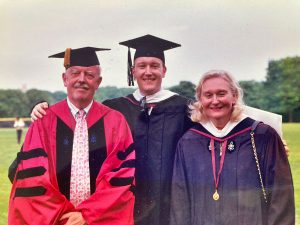
“I consider him kind of a Renaissance man because he had a way of linking music to the literature that he taught,” she said.
She harkened back to Hoar’s lessons for 30 years in her work as a high school Spanish teacher in Rockville Centre, New York.
“I was able to bring my enthusiasm, which I had caught from Dr. Hoar to my students to get them excited about poetry and literature,” she said, noting that her fond memories of Fordham inspired her to join a University Women’s Giving Circle.
“One of the reasons that I keep supporting Fordham is because of my memories of Dr. Hoar.”
A Life Filled with Joy
Arnaldo Cruz-Malave, Ph.D., a professor of Spanish and comparative literature, said Hoar was an important member of the “MLL family.”
“I remember him most toasting to others and laughing. His generosity on these occasions and his great sense of humor, which were a balm during difficult times, is what I will remember and cherish most about him,” he said.
Clark remembered Hoar as an avid sailor who sailed out of the Bronx’s City Island with his friends and family. When Clark became chair of the department, he said, Hoar gave him a bottle opener, a bottle of champagne, and a note that captured his spirit quite well—’Enjoy the bubbly, and remember what Napoleon said about champagne: In victory you deserve, it and in defeat you need it. In your case, it’s victory!”
“One of my favorite memories is when Leo and Georgine returned to Fordham for a spring departmental party in 2017. They were impeccably dressed, deeply gracious, and filled with youth. With a live Mariachi band playing, the two started dancing together with some pretty impressive moves. It inspired others to join in. You could see that there was great love between them and a life filled with joy, appreciation, and happiness,” Clark said.
“We will miss him and are blessed with the energy and contributions he gave to the department over many decades.”
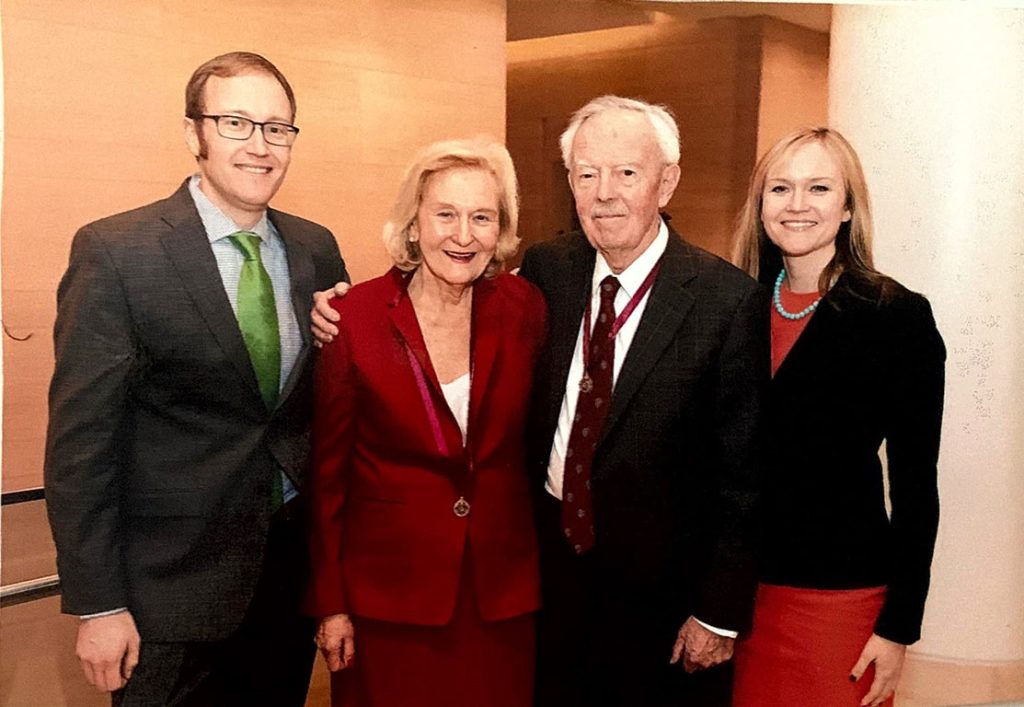
Hoar is survived by his wife, Georgine Barna Hoar; his daughters Jennifer Hoar and Judith Tietz; his son, Leo Hoar III; his sister, Nancy Gunning, and many loving nieces and nephews.
A wake will take place at McGrath Funeral Home in Bronxville, New York, on Thursday, June 30, from 6 to 8 p.m. A Mass of Christian Burial will be held at St. Joseph’s church in Bronxville on Friday, July 1, at 10:45 a.m.
]]>“Academic writing is often inaccessible to the people whom the findings most affect, especially young people of color in public high schools,” said Ayala Fader, Ph.D., project collaborator and professor of anthropology at Fordham. “We hope that this workshop gives students access to scholarship on language and inequality and the ability to reflect on how these subjects affect their own lives, while showing them what college life and careers in linguistic anthropology look like.”
This new writing initiative, the Demystifying Language Project (DLP), began with a three-week pilot class in 2019. In collaboration with Fordham’s Center for Community Engaged Learning, two non-Fordham graduate students taught high school students a class on linguistic anthropology, which included simplified academic readings. But at the end of the pilot session, the DLP team realized the teaching material was still too dense and incomprehensible for the students.
“This is tragic because high school students are losing the potential to better understand the ways that language, culture, and power work in the world,” said Fader, a linguistic anthropologist who studies the relationship between language, culture, and inequality. “During the pandemic, the DLP team decided to focus on creating a set of readings that are accessible to all high school students.”
Fader is collaborating with five other scholars: Sarah Grey, Ph.D., director of Fordham’s linguistics program; Britta Ingebretson, Ph.D, assistant professor of linguistics and Chinese at Fordham; Johanna Quinn, Ph.D., assistant professor of sociology at Fordham; Clarence Ball III, a lecturer in Fordham’s Gabelli School of Business; and Lynnette Arnold, Ph.D., an assistant professor of anthropology at University of Massachusetts Amherst.
Together, they decided to create a three-day workshop, funded by the grant, where traditional roles in the classroom are reversed. Next year, a group of 12 experts in linguistic anthropology and sociolinguistics will each select an article they have already published—on topics that are relevant to the students, including police violence, food insecurity, and other inequalities—and work with the students to make the writing more engaging for their high school peers. First, each expert will be paired with a high school student and a Fordham undergraduate who has taken an anthropology or linguistics class; they will review the original article and interview the expert about their work. Then after collaboration with other professionals, each expert will figure out how to distill their work into two pages of simple and interesting prose for a high school student.
“Students will ask the academics about what was interesting and what they didn’t understand, and tell them the most important part about the article from their eyes,” Fader said. “We hope this develops a new way of writing that reaches more people beyond the usual academic audience.”
The revised articles will be published on the American Anthropological Association’s website, where students, teachers, and faculty from other academic institutions can read the material and learn how to integrate it into their own curriculum, said Fader. In addition, the DLP team will publish two pieces: an academic article that documents what it was like to develop and host the workshop and an op-ed that explains their experience in conversational language.
In the months ahead, the DLP team will focus on strengthening relationships with local public high schools in Manhattan and the Bronx. This spring, they will select specific schools to partner with. They will cultivate bonds among all participants so that when the day of the workshop arrives—sometime next year, though the date has yet to be determined—the participants will be ready to collaborate on Fordham’s campus.
“We are potentially creating a set of tools to help high school students make positive changes in their own lives,” said Fader, adding that the DLP team wants to eventually develop a summer institute where more high school students and teachers can learn these same ideas. “This workshop is not only good for students, but also has the potential to transform the field of linguistic anthropology and sociolinguistics as more students—both undergrads and high school students—conduct their own research and hopefully become interested in the field.”
]]>So when Fordham ceased face-to-face instruction at 1 p.m. on Monday, March 9, due to the threat posed by the COVID-19 outbreak, faculty were faced with the challenge of providing quality instruction that was true to their mission of supporting students and continuing to foster their potential. On March 13, the decision to suspend face-to-face classes was extended through the end of the semester.
As they begin to deliver instruction remotely, faculty have turned to online tools such as Zoom, WebEx, Blackboard, and Google Hangouts to continue students’ education. And they have turned to each other for support, guidance, and tips.
Planning for the transition began in earnest during the last week of February, when Joseph M. McShane, S.J., president of Fordham, and Dennis Jacobs, Ph.D., provost and senior vice president for academic affairs, briefed members of the Faculty Senate at its monthly meeting on February 28. Administration officials had been monitoring the spread of the virus in China, and once a case had been reported in Washington state in January, they thought it might spread throughout the United States.
Jacobs said that at that time the University was already making plans to offer online instruction to students who’d been recalled from study abroad programs and who would need instruction while self-quarantining.
“That was the call to action, to say, ‘Let’s begin preparations,’” he said.
“No one would have chosen this as a normal transition path, but these are extraordinary times, and our options were limited,” he said.
“Everyone was committed to serving our students and allowing them to progress towards their academic degrees. It was not just an option to shut down the campus, we had to come up with a continuity plan.”
Technology and Pedagogy
Making the transition required overcoming challenges both technical and pedagogical. Steven D’Agustino, Ph.D., Fordham’s director of online learning, is helping faculty figure out how to best use that technology to deliver their coursework. He’s offered videos and documentation on the University’s Official Online Learning Page and his blog, Learning at a Distance.
D’Agustino said he was impressed at how seriously faculty have put students’ well-being and peace of mind first and foremost. Many are using this week, which happens to be spring break, to explain to their students how they plan to move forward with the rest of the semester and taking steps like telling them exactly what times of the day they’ll be checking their emails. Faculty are establishing virtual office hours when they’ll be available for in-person consultation, and giving serious thought to whether future classes should be held synchronously, when everyone meets together, or asynchronously, which enables students to access material on their own schedules.
D’Agustino encouraged faculty to evaluate their methods as they go, and to draw on the experiences of peers across the country who face the same situation.
“I would say reflective practice is really valuable. This about what you’re doing, and reflect upon it after you’ve done it, and try to include your students and your colleagues in those reflective spaces. Because I think there are a lot of good ideas and support out there, and we’re not alone.”
A Quick Turnaround
Eve Keller, Ph.D., professor of English and president of the Faculty Senate, said she was astonished at how quickly faculty, who teach nearly 2,000 courses a semester, were able to work together to make the transition.
“Faculty had 36 hours to convert their classes online. Some people have done this, and some people had never heard of Zoom, but from what I’ve seen, it’s been an unequivocally congenial, collegial effort to make it happen,” she said.
The transition has not been without occasional hiccups. Anne Fernald, Ph.D., a professor of English and special adviser to the provost for faculty development, emailed fellow arts and science faculty for thoughts on pedagogy on March 11, and after receiving 20 replies, she felt prepared.
Still, when she attempted to teach her first class on Thursday with WebX, she didn’t realize the program’s default volume setting for the program is mute. She ended up recording a podcast for it with the information she planned to share, and is confident she’ll be able to make it work next week, when spring break ends and classes resume.
“I felt like the University did everything it could in this emergency to support us. And I think that the decision to be closed on Tuesday and give people time to prepare was huge. I had colleagues all around the country who didn’t have anything like that. Fordham did it in a way that was as compassionate as it could be,” she said.
Striking the Right Balance
On March 12, Mark Conrad, an associate professor of law and ethics at the Gabelli School of Business, taught three courses—Legal Framework of Business, Sports Law, and Law and the Arts—using the Zoom platform, and was happy with how it came together.
“I’ve been pleasantly surprised at how easy and accessible it has been. I had a number of questions from students. I wasn’t just talking to a computer,” he said, noting the ease in which he was able to share power point slides with students.
“We’re seeing future possibilities. It deals with something I’ve been thinking about which is, let’s say the professor is ill or has a sprained ankle. One could do classes like this, and it could actually minimize absences.”
Nicholas Tampio, Ph.D., a professor of political science, taught two classes on March 11 using WebX seminar after department chair Robert Hume, Ph.D., arranged practice sessions for the department. While they went off without a hitch, he said it was hard to read the mood of a room, as many nonverbal communication cues were lost in translation.
“When you teach online, you can’t see feet shifting, or if they have another browser open where they’re checking email. Their parents could be in the room, there could be a car going by. It’s not a controlled environment in which students are only there for the experience,” he said.
“I think I’m going to get better over time at being able to call on people, and I think I’m going to get better at organizing my slide show to make it more entertaining,” he said. But he acknowledged that face-to-face learning will always be preferable.
Edward Cahill, Ph.D., a professor of English, had never used Google Hangouts before and turned to it to teach Shakespeare’s sonnets and John Milton’s Paradise Lost. He found it to be similar to the normal classroom experience, although he said he plans to try different approaches to keep things interesting when the semester resumes, including splitting the class into both synchronous and asynchronous sessions.
Cahill’s new familiarity with online learning comes not only from his work as a professor, but also a student. His experience as a student in an entry-level Spanish class taught by Guillermo Severiche has given him hope that success is possible in the online realm, he said. Severiche, an instructor in the department of modern languages, moved their class to Zoom as well.
“We share documents, we used the e-textbooks. He managed the whole thing flawlessly. So that inspired me to think maybe I can do more.”
Cahill noted that he’s trying to be mindful of the challenges inherent in asking students to complete studies in the midst of a worldwide pandemic.
“There are so many balances to strike between rigor and flexibility, generosity and intensity. I don’t know that anyone has figured it out, and I guess as long as we can stay alert to all of those tensions, we’ll probably find our way through it,” he said.
Doing Lab Work Without the Lab
In some fields, resuming instruction is trickier than just establishing online connections. Stefanie Bubnis, interim managing director of the Fordham Theatre Program, said that while mainstage productions have halted, faculty have bolstered instruction on Google Hangouts and Zoom with old fashioned phone calls and FaceTime.
Professors such as Ann Hamilton, an adjunct professor of theater, are learning on the fly as well. For her first online Acting for the Camera class, she asked students to upload the scenes they recorded of themselves to Hightail and Google Drive. She watched the videos during the designated class time and wrote feedback in a group email to the 17 students in the class. Ultimately it proved to be too time-consuming.
“For my next class I intend to use Zoom, so we are all conferencing together, but they will have sent me the recorded auditions first, so I can have them up on my desktop and we can all watch them together at the same time and actively participate in the feedback. I think the students felt as if they learned a lot today, so that’s a win, given the circumstances,” she said.
Stephen Holler, Ph.D., an associate professor of physics, was able to move the lecture for his General Physics 2 class exclusively to Blackboard, but that wasn’t an option for Experimental Techniques for Physics, a course where teams of students had been working on a single project all semester.
“Some of the work, they’re in the machine shop, they’re doing 3D printing, they’re doing electronics,” he said, noting that this work will have to be completed in a different way than planned.
“Since they’ve done half the project, and they’ve already written up progress reports, I’ll have them turn those progress reports into a paper. Normally I’d also have them do a presentation on a research project they’re interested in; instead I’ll have them write a short paper on that and we’ll do Zoom presentations.
A Big Shift for Information Technology
For Fordham IT, the switch required an unusually speedy response.
Alan Cafferkey, director of faculty technology services, noted that his team—which includes experienced technicians, a fine arts and digital humanities professional, instructional designers, a former math teacher, a librarian, adjunct professors, a media and accessibility expert, and an Ed.D. candidate—normally prefers to work with six months lead time to develop an online course.
“This, however, was everyone already two months into the semester with only a couple of weeks of realizing that something might happen, prepping, and then a sudden shift, with hundreds of people making the change,” he said.
He was especially proud that his team was so on top of responding to the multitude of individual faculty requests. In addition, in collaboration with the provost’s office, they created a Course Continuity site before the University shifted to online learning—as preparation for what might happen.
When the switch was made, IT as a whole simultaneously shifted its entire operation to function remotely—including the IT Customer Care help desk—while helping other offices do the same.
IT also rolled out an entirely new enterprise-wide system in Zoom, reinforced numerous systems, and conducted a multitude of workshops on topics such as teaching synchronously and asynchronously, setting up remote offices, and best practices for many popular web tools. Additional workshops will continue through the spring and can be found on the department’s blog.
Going forward, Cafferkey said the department will continue to field faculty questions and requests, work closely with vendors such as Blackboard, and support other University initiatives as needed. He credited the efforts of colleagues across IT, the provost’s office, the IT departments in the Gabelli School of Business and Fordham Law, the online learning teams at the Graduate School of Social Service and the Graduate School of Education, and the staff at Fordham’s library.
“I’ve been really touched at how kind most of the faculty have been about the support provided. I’ve gotten so many thoughtful notes and comments, it’s been really heart-warming. It’s helped that there are so many offices working collaboratively,” he said.
Looking at the Big Picture
Lisa Holsberg, a Ph.D. candidate in theology, found herself transitioning Great Christian Hymns, which she is teaching for the School of Continuing and Professional Studies (PCS), entirely online. But she was in some ways already prepared to do so, as she is also currently teaching an online course, Christian Mystical Texts, for PCS. She was already accustomed to using Blackboard extensively, as well as Screencast-O-Matic and Voicethread, which lets students listen to each other talk, in their own words, about a specific problem. But ultimately, technology is just one little piece of the story, she said.
“It’s really, what is your commitment to students and to learning and going forward in the midst of change? How do you rethink what it means to teach, what it means to learn in conditions you’re not used to? You have to really dig deep into what your fundamental commitments are to your teaching, your students, to yourself, to your topic, and then just use whatever tools you have in order to meet those goals,” she said.
The Path Forward
Going forward, D’Agustino said he thinks faculty will settle into a hybrid approach for the rest of the semester, making tweaks as they get feedback from students.
“They may say, ‘We’re going to do a synchronous session, so here are the slides in advance, here is the reading material, here’s the study guide, there are some questions you should be able to answer during the session,’” he said.
“So even if a student can’t attend or log in, they still have the notes, the readings, the study guides, and they can say, ‘Professor I couldn’t log in; its 4 a.m. for me. But here are the answers to those questions. And the faculty member can, if it’s part of their protocol, share those answers with the class so that student is part of it.”
Jacobs said that he’s hopeful that faculty will rise to the challenge in what is an extraordinary time of upheaval. He noted that online instruction will always have a place in graduate level and professional-oriented instruction, especially for students who are working or have family obligations. As such, the University will continue to evaluate it on a case-by-case basis. But face-to-face teaching and learning is at the heart of Fordham’s mission, he said.
“Jesuit education is really one of formation in context of community. We treasure that at Fordham, and we always will. It’s the reason why during the academic year, we have not, by intention, moved our undergraduate academic offerings into an online format. We’ve offered them face-to-face, and will return to that when it safe to do, when the virus has passed,” he said.
]]>

 Dixa Ramírez, Ph.D., assistant professor at Brown University, explored racial identity in the Dominican Republic in her lecture “Dominican Blackness, Ghosting, and Bad Patriots” at the Lincoln Center campus on Sept. 26.
Dixa Ramírez, Ph.D., assistant professor at Brown University, explored racial identity in the Dominican Republic in her lecture “Dominican Blackness, Ghosting, and Bad Patriots” at the Lincoln Center campus on Sept. 26.
“Some of you might be familiar with the joke about Dominicans as those black people who don’t know or think they’re black,” Ramírez said to a group of Fordham students and staff in Lowenstein’s South Lounge. “My book Colonial Phantoms shows both why this has come to be and why there’s a problem that it’s the primary way in which Dominicans are discussed in various conversations with the U.S., the Caribbean, and beyond.”
Her talk, which took place during National Hispanic Heritage Month, was part of a Fordham lecture series about Hispanic Caribbean women writers who examine the intersection of race, gender, and imperialism in their work. The series is sponsored by the Office of the Dean of Arts and Sciences; the Department of Modern Languages and Literatures; the Center on Race, Law, and Justice; the department of African and African American studies; the Latin American and Latinx Studies Institute; and the Comparative Literature program.
In a presentation that mixed music with academia, Ramírez spoke about her award-winning book, Colonial Phantoms: Belonging and Refusal in the Dominican Americas, from the 19th Century to the Present, published by New York University Press last year. The book details how decades of literature, music, and speech show Dominicans’ ambivalent relationship toward blackness, thanks to its unique racial history: Unlike many nations in the Americas and the Western World, the Dominican Republic, for centuries, had a majority mixed-race and black population that was free. For years, Dominicans have tried to distinguish themselves from the New World narratives that have “ghosted, misunderstood, or acknowledged them only as inferior others” through creative outlets, she said.
One example is the music video “El Tigeraso” by Maluca Mala, an Afro-Dominican artist born and raised in New York City. The song opens with Maluca Mala sitting in “a quintessential Dominican site—the hair salon,” said Ramírez. To many U.S. scholars, her decision to go to a salon to straighten her hair represents a Dominican’s denial of his or her blackness, said Ramírez. But when Maluca Mala leaves the salon, she keeps the rollers in her hair. In other words, she demonstrates “an ambivalent kind of black performance that is neither outright denial [of blackness] nor the kind of celebration we expect in the U.S.”
“She is neither wholeheartedly embracing Dominican women’s hair-straightening practices, rooted of course in the racist notion that black hair is bad, nor is she rejecting the practice of going to the salon by wearing her hair in natural curls. Instead, she stops the process midway,” Ramírez explained. “Her embrace of the rollers is a complicated embodiment of both African diasporic and diasporic Dominican subjectivity.”
In a Q&A session, Ramírez spoke about what motivated her to study the relationship between race and Dominicans.
“It might seem like the obvious answer is because I’m Dominican. But actually, my major in college was Japanese literature,” she said, to laughter from the audience. She was born in Santo Domingo, the capital of the Dominican Republic, and raised in the Bronx. But it wasn’t until graduate school that she became fascinated by the history of her homeland and the Caribbean.
Sitting in the audience was Yuko Miki, Ph.D., associate professor of history at Fordham, a fellow Brown alumna who studies Brazilian history.
“I’m a historian of slavery, too,” Miki said to Ramírez. “How do you talk about blackness in the D.R. without imposing U.S. or even Haitian categories of blackness onto it?”
Ramírez urged her to feature different narratives of race, especially the ones that are often left in the dark: “The narrative of Dominicans as white nationalists and anti-black is the louder story. So kind of turning down the volume to hear the other stories, which include various forms of black pride,” Ramírez said.
A student in the audience asked Ramírez a more personal question: how can a person navigate their racial identity, especially for those from a country that experienced colonization.
“A question that I’ve asked myself my whole life—and also that I know a lot of other people ask—is with this type of history, how can we come to remedy or just find our own narratives and ways of identification?” the student asked.
Ramírez struggled to address the question. Ultimately, it was the student’s responsibility to find the answer—not another person’s, Ramírez implied.
“Maybe that’s the answer—that I’m writing against this idea that people with certain backgrounds whose ancestry has been subject to so many layered colonialisms, that … we are given some room to work through those histories without impositions—especially from different spaces of power—in how we define ourselves,” Ramírez said.
]]>It’s a phrase that’s uttered often in Jesuit circles, and at Fordham, it’s been exemplified through programs such as the Dorothy Day Center for Service and Justice and Global Outreach.
This year, as part of an effort to advance and expand that work, Fordham’s Office of Mission Integration and Planning launched the Center for Community Engaged Learning.
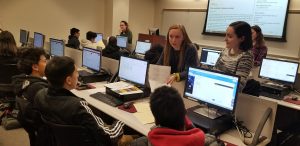
Arto Woodley, Ed.D., the center’s executive director, said the goal is to streamline operations, provide support for faculty who integrate community-engaged learning in their classes, and help students become civic leaders.
He also wants to instill what he calls a “philosophy of community.”
“When we say, ‘We’re working with the community,’ what does that really mean? Are we working with certain neighborhoods? Are we working with certain zip codes? What’s our emphasis? How do we engage with them?” he said.
“Part of developing this center helps us say, ‘Who are our neighbors? Who are we working with, and why are we working with them? What will be the impact of our work?’”
A Focus on Faculty
As part of the reorganization, the Dorothy Day Center and Global Outreach no longer operate as independent entities. Former Dorothy Day Center director Roxanne De La Torre has assumed the title of director of campus and community leadership in the larger center. Likewise, Paul Francis, who had been director of Global Outreach, has assumed the title of director of programs and operations.
Woodley said the level of community outreach, leadership development, and faculty support should increase significantly with the reorganization. This, he said, will honor the legacy of Day, for whom the University’s Community Service Program was renamed in 2009.
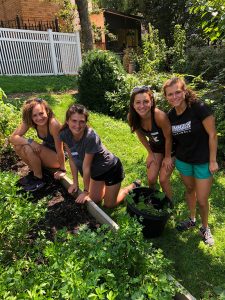
Faculty will be a key part of the center’s new focus. That’s because like the residents who live near Fordham’s campuses, they have long-lasting ties to the community. The goal is to develop deep and sustainable relationships between the two groups that will provide a context for students to learn.
“At many institutions, it’s activity-based. You know, we sent 50 students to a soup kitchen, they stacked 100 cans, and they gave those cans to five families. Our whole goal is to make sure we expand the boundaries of engaged scholarship beyond that,” he said.
Not every subject taught in the University naturally lends itself to engaged scholarship, but for some professors, it is a powerful tool. Karina Hogan, Ph.D., an associate professor of theology who was part of a faculty advisory committee on community outreach, plans next semester to have students in her Sacred Texts of the Mideast class examine the ways in which Judaism, Christianity, and Islam address themes of social justice in their texts. They will split into three groups and work out of a New York City synagogue, church, and mosque, where they will be able to observe how members of the respective congregations put words into action.
“The idea is to really get out and see how these ideas are actually put into action. I think it’ll be a good addition to the class,” she said.
“They Live In This Community”
For Carey Kasten, Ph.D., associate professor of modern languages, it would be inconceivable not to send students in her Spanish Language and Literature class off campus.
“They live in this community, and I want them to see that they’re capable of engaging civically with their community, ” she said.
“Speaking in a different language creates foreign travel opportunities in the city we live in, but ultimately, I would like to students to apply those skills to everything they do.”
In the past, Kasten has found partner organizations to work with both on her own and through the Dorothy Day Center. It can be a logistical challenge; since many only need three to four students, she works with several different groups to place all her students. She’s intrigued by possible connections the Center for Engaged Learning will create, and hopes they will add to those that happen organically.
A good example is the immigrant support group New Sanctuary Coalition, she said. Although many students have been referred there via faculty, several have found the group on their own and incorporated volunteering there into their own studies.
Ideally, Kasten said, she’d also like to connect volunteer opportunities to her research agenda, something that Woodley said the center will focus on as well.
“I’ve really struggled with how to bring some of this work out of the classroom and into my research. I hope to see examples from faculty members on how to do this,” she said.
Scholarship Intertwined With Civic Involvement
One of Kasten’s students, Colleen Kelly, a senior at Fordham College at Lincoln Center who’s majoring in social work and Spanish, used a Dean’s Summer Research Grant to intern last summer at the Northern Manhattan Immigration Corporation. She was interested in learning what it actually means for New York City to be a sanctuary city.
She learned that immigrants who are in the country legally are being discouraged from applying to become citizens because seemingly minor crimes—such as jumping a turnstile—on their record might trigger a visit from Immigration and Customs Enforcement.
“In this time, it’s very critical to have an open definition of sanctuary and realize, in terms of the immigrant community, it’s always changing because the current administration is instilling a lot of fear of anyone who’s not a citizen,” she said.
“So anyone that’s not a citizen is really in need of sanctuary, in the form of community.”
Both this internship and one she’s currently doing at a school in the Bronx, where she’s assisting a social worker, have been directly informed by her classwork.
“I also know if a client comes to me and they need help with their asylum connection, I now have connections,” she said.
“Growing my network is not only great for my own job prospects but also my clients I’m going to serve.”
Woodley said establishing successful partnerships will go a long way toward helping Fordham fulfill the tenets of its Jesuit heritage.
“When Jesus was asked by the Sadducees what the greatest commandment was, he said to love the Lord thy God with all your heart, mind, and soul, and to love thy neighbor as yourself,” he said.
“The center is the ‘love thy neighbor’ part of it, but with a system that’s tied to engaged scholarship.”

Paul Novak, Mariam Moustafa, and Amelia Ahn were part of a team of Fordham College at Lincoln Center students who competed with students from Columbia and New York Universities to tackle influential French poet Arthur Rimbaud’s famous assertion that, Je est un autre (“I [am]somebody else”).
Held at the French Embassy in Manhattan, the annual competition of eloquence challenged students to answer in French the complex question—“Do we experience ourselves as if it belongs to another person?”
“In the working world, public speaking is a vital skill to have, and students learned some valuable lessons about confidence and engagement,” said Hélène Godec, an artist-in-residence of Fordham’s Department of Modern Languages and Literatures, who helped the students prepare for the competition.
Ahn, in her presentation “The masks that we wear,” argued that when we use social media we’re not actually portraying our true selves. Rather, we are presenting an “other” self.
Ahn said she enjoyed presenting her ideas because it helped to her to become more comfortable speaking in public.
“It was a good learning experience,” she said.
Novak used Jean-Paul Sartre’s description of anti-Semitism and Jewishness to explore the philosophical concept of “alterity,” or otherness, in his presentation.
“The largest point of my piece was about how fear of the unknown and ignorance toward others is what creates ‘the other,’” he said.
He said the competition allowed him to further immerse himself in the French language.
“Hearing native and non-native speakers present their ideas is a great chance to practice listening, conversation, and overall interlingual communication,” he said.
]]>But how does hearing diverse languages affect language comprehension and processing?
In her new research, “Foreign-accented Speaker Identity Affects Neural Correlates of Language Comprehension” published in the May 2017 Journal of Neurolinguistics, Sarah Grey, Ph.D., found that a listener’s ability to identify foreign-accented speech affects their brain’s grammatical and semantic processing.
“In our daily lives, we’re interacting with people who are potential non-native speakers of a language, but we don’t have a lot of knowledge about how native speakers are processing what they hear,” said Grey, an assistant professor of linguistics and Spanish in the Department of Modern Languages and Literatures.
The study that Grey conducted with Janet G. Van Hell, Ph.D., a professor of psychology and linguistics at Pennsylvania State University, examined the brain activity of 29 monolingual native English-speaking college students living in central Pennsylvania, where English is mostly spoken. None of the participants were currently studying a foreign language and all of them reported limited experience hearing foreign-accented speech.
In the study, participants were told that they were going to be hearing two people talk about their friends’ lives. The task was to listen to sentences related to their discussion. They were not told that the sentences were going to be spoken by a native English speaker and a non-native Chinese-accented speaker, and there was no prior mention of foreign accents, grammar, or semantics.
Some of the pre-recorded declarative sentences, which were delivered by two female speakers, were grammatically and semantically correct. However, other sentences had a grammatical error in English subject pronouns (“Thomas was planning to attend the meeting, but she missed the bus to the school”) or a semantic error (“Kaitlyn traveled across the ocean in a cactus to attend the conference.”)
The researchers examined how the participants processed native and foreign-accented sentences through two methods: First, the neurocognitive technique of event-related potentials (ERPs), which are acquired with electroencephalogram, or EEG data. This allowed them to measure the electrical activity of the brain as listeners were processing the sentences they heard.
“One of the advantages of EEG is that you’re getting a closer look at brain processing in real time,” said Grey. “That’s a very fine level of detail that we don’t always get when we’re looking exclusively at behavioral data.”
Secondly, researchers measured sentence comprehension, language attitudes, and accent perception among the 29 listeners being tested.
The results from Grey’s study showed that being able to recognize foreign-accented speech seems to affect not only semantic processing, but also aspects of processing grammar. Both groups of listeners showed reduced semantic processing of foreign-accented speech compared to native-accented speech. However, for processing the grammar, the patterns of the two groups of listeners differed, she said.
“Listeners who could successfully identify foreign-accented speech had more active brain responses during grammar processing than the listeners who couldn’t identify the accent,” said Grey.
A global reality
As the United States continues to grow as a culture where many different languages are spoken and heard, Grey said her research on language comprehension is providing a deeper understanding of how bilinguals and monolinguals process the language around them. According to Grey, these changes are also reflective of a global reality.
She said she doesn’t have to look much further than the Bronx to see the impacts of multilingualism. According to the U.S. Census Bureau’s 2015 American Community Survey, 60.1 percent of Bronx residents speak a language other than English.
“Fordham is located in a linguistically rich area, which is incredibly attractive [for my research],” she said.
Most recently, Grey set up an EEG laboratory for Language and Multilingualism Research at the Rose Hill campus to conduct more experiments on language learning and comprehension— with the first set of data collection planned for later this year.
“We’d like to continue to look at language processing in groups of bilinguals to see if their own statuses as bilingual speakers also impact their brain responses,” she said.
Challenging misconceptions
Through her research on language processing, Grey hopes to also challenge misconceptions about foreign-accented speech.
“Oftentimes hearing foreign accentedness, or even dialectic accentedness, brings up a preconceived set of biases,” she said. “People often assume that the person may not be a high proficiency speaker of the language, may be brand new to a language, or that they may have ideological differences.”
Grey’s own experiences learning Spanish as a native English-speaking high school student, and later at the undergraduate level, provided her with a well-rounded perspective on language learning and comprehension, she said.
“It was through my own foreign language experience that I got interested in the more technical aspects of language study related to linguistics,” she said. “And I just followed that to where I’m at now.”
Grey plans to use Fordham’s EEG laboratory for Language and Multilingualism Research as a gateway for students to learn how multilingualism is transforming not only the world, but the Bronx community in which the Rose Hill campus is based.
“Most people around the world are bilingual or multilingual, or live in a context where bilingualism and multiculturalism are a daily reality,” she said.
“[The lab] gives students a different view of language learning and comprehension because we’re using neuroscience methods to examine foreign language learning and bilingual language processing. That’s kind of a novel way to think about [the study of]modern languages.”
]]>Produced by L’Atelier Theatre Productions, Les Bonnes (The Maids), which runs through March 19, is based on a provocative 1947 play by French dramatist Jean Genet. It follows two sisters working as chambermaids, Solange (Hélène Godec) and Claire (Laura Lassy Townsend), as they plot an uprising against their master madame (Cloé Xhauflaire).
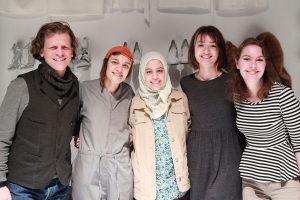
The experimental production, directed by Oliver Henzler, is performed in French with English subtitles created by Fordham College at Lincoln Center students Lucy O’Brien and Mariam Moustafa; and Fordham College at Rose Hill student Ellen Thome.
The students joined the Les Bonnes production team as part of an independent internship with Godec, who teaches courses in French theater and business culture. An accomplished French actress and oral communications expert, Godec runs a weekly atelier in French for Fordham students. Her credits include Dialogues en soliloque, Les nuits de la colère, and Au dessus des chiffons.
Working with Godec on the poetic Les Bonnes, provided a real-world experience in theater and English/French translation, the students said.
“The most challenging part happens as we run the subtitles when the actors change lines or skip a scene,” said Moustafa. “We start running through the PowerPoint [and]it is literally a mini panic attack trying to match the English subtitles with the actress’ lines in the play. But after the show, we laugh at these moments and we make sure to do our best the following show.”
O’Brien said the fast-paced nature of the play also has its perks.
“My translation skills have gotten infinitely better because I had to think on the spot,” she said.
Through the play’s physical movements and the students’ English subtitles, English-speaking theatergoers are able to immerse themselves in the play’s riveting storyline, the actress said.
“You can watch the performance without understanding every spoken word,” said Godec.
“We don’t approach our roles on a psychologically realistic level. I enjoyed exploring my character in a very visceral way.”
]]>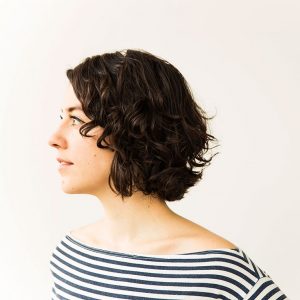
Contributed Photo
Sophie Pinkham, a journalist and activist who witnessed corruption, poverty, substance abuse, ethnic clashes, and Russian aggression during a seven-year-long visit in Ukraine, will share her insights at Fordham’s Russian Forum.
March 9th
4 – 5 p.m.
Fordham Law School, Room 3-09
Lincoln Center Campus
Pinkham, who first visited Kiev in 2007, detailed her time in the country in Black Square: Adventures in Post-Soviet Ukraine! (W. W. Norton & Company, 2016).
During that time, the nation experienced the Maidan Revolution of 2013–2014, Russia’s annexation of Crimea, and the ensuing war in Eastern Ukraine.
Riley Ossorgin, Ph.D., lecturer in the Department of Modern Languages and Literatures, is coordinating the forum, which will consist of a series of talks on topics related to Russia. He said he invited Pinkham to speak because she can testify to both the “absurdity of life” in a place where the influence of Russian President Vladimir Putin is inescapable, as well as how the situation there is relevant to the United States today.
“We have a new relationship with Russia, and we should know how they negotiate international relations with other countries. Pinkham’s book covers that, as well as offering cultural information about the tensions between Ukrainians and Russians,” he said.
Ossorgin said that the book features interviews with Ukrainians who wanted to connect with Russians, even though they were ideologically opposed to their political ideas.
“That is powerful, and much needed in a time when our political parties are speaking completely different languages,” he said.
Julia Alekseyeva, an artist who published the graphic novel Soviet Daughter: A Graphic Revolution (Microcosm Press, 2017), will be the forum’s guest speaker on March 30. Ossorgin said he’s in the process of booking a third speaker to talk on architecture or graphic arts.
Recent revelations that Russia attempted to influence the U.S. presidential election have made the forum conversations even more important, he said.
“Is the U.S. relationship with Russia worsening, and, if so, what does that mean?” he said. “We need experts who have lived there, who know how Putin runs things, and who understand the laws that have been passed.”
]]>